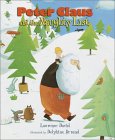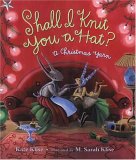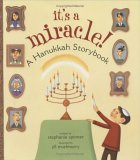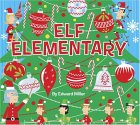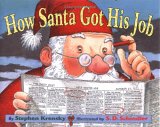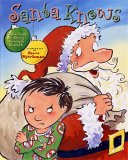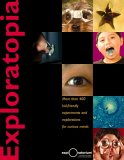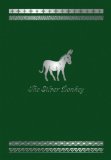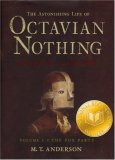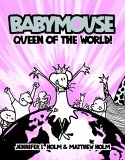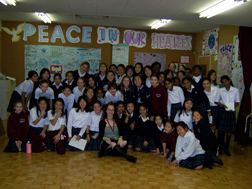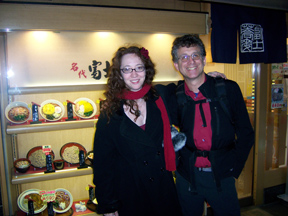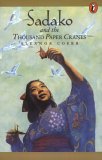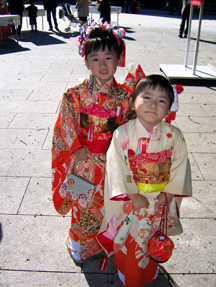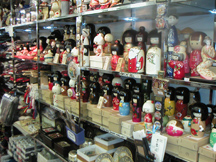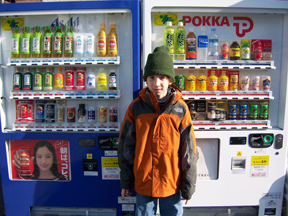 HAP-py New Year! Corks are a-popping here, because I'm very proud that since this blog's inception last summer, PlanetEsme has posted reviews and recommendations for over 130 books published in 2006, and at least as many "backlist" (older) titles. Below is a list of the new books (titles with an asterix are slotted to be reviewed in the coming weeks). I always love looking at the complete list of favorites because it is not only a reminder of what talent and beauty springs eternal from the pond, but a reminder of how possible it is to get a engaging and well-rounded base of knowledge using children's literature. If a child were to read every book on this list through the year...well, there's a potential for equal education within the pages, regardless of where a child lives or how much money a child's parent makes. Even after a night's worth of champagne, that is one sobering thought. So let us pour one last glass and raise it high in honor of libraries, parents and teachers who prioritize read-aloud, independent booksellers who work hard to get the best into our hands, and all who live the change they wish to see in the world through literacy. Chin-chin!
HAP-py New Year! Corks are a-popping here, because I'm very proud that since this blog's inception last summer, PlanetEsme has posted reviews and recommendations for over 130 books published in 2006, and at least as many "backlist" (older) titles. Below is a list of the new books (titles with an asterix are slotted to be reviewed in the coming weeks). I always love looking at the complete list of favorites because it is not only a reminder of what talent and beauty springs eternal from the pond, but a reminder of how possible it is to get a engaging and well-rounded base of knowledge using children's literature. If a child were to read every book on this list through the year...well, there's a potential for equal education within the pages, regardless of where a child lives or how much money a child's parent makes. Even after a night's worth of champagne, that is one sobering thought. So let us pour one last glass and raise it high in honor of libraries, parents and teachers who prioritize read-aloud, independent booksellers who work hard to get the best into our hands, and all who live the change they wish to see in the world through literacy. Chin-chin! January is also the hellatious month of children's book awards. Though I am looking forward to the results of the Cybils, a new blogger-based award that has helped to create the year's best reading lists in cyberspace or anyplace, generally my feeling about awards is that I wish everything could be like in Ezra Jack Keats' PET SHOW, in which every entrant received a ribbon for whatever outstanding trait it might have ("friendliest fish" stands out in my mind). In which case, I might start handing out ribbons like these:
January is also the hellatious month of children's book awards. Though I am looking forward to the results of the Cybils, a new blogger-based award that has helped to create the year's best reading lists in cyberspace or anyplace, generally my feeling about awards is that I wish everything could be like in Ezra Jack Keats' PET SHOW, in which every entrant received a ribbon for whatever outstanding trait it might have ("friendliest fish" stands out in my mind). In which case, I might start handing out ribbons like these:Favorites for sharing in a classroom setting:
LIBRARY LION by Michelle Knudsen, illustrated by Kevin Hawkes (Candlewick)
THE SHOW AND TELL LION by Barbara Abercrombie, illustrated by Lynn Avril Cravath (McElderberry)
HOUNDSLEY AND CATINA by James Howe, illustrated by Marie-Louise Gay (Candlewick)
WHO IS MELVIN BUBBLE? by Nick Bruel (Roaring Brook)
BEST SHORTS: FAVORITE SHORT STORIES FOR SHARING selected by Avi and Carolyn Shute, afterword by Katherine Paterson, illustrated by Chris Raschka (Houghton Mifflin)
LUGALBANDA: THE BOY WHO GOT CAUGHT UP IN A WAR (AN EPIC TALE from ANCIENT IRAQ) by Kathy Henderson, illustrated by Jane Ray (Candlewick)
AN EGG IS QUIET by Dianna Hutts Aston, illustrated by Sylvia Long (Chronicle)
HOW WE ARE SMART by W. Nikola-Lisa, illustrated by Sean Qualls (Lee and Low)
Made me laugh the hardest:
CHICKENS TO THE RESCUE by John Himmelman (Holt)
MR. PUSSKINS: A LOVE STORY by Sam Lloyd (Atheneum)
SUPERHERO ABC by Bob McLeod (HarperCollins)
Best children's books actually for grown-ups:
SO FEW OF ME by Peter H. Reynolds (Candlewick)
THE ASTONISHING LIFE OF OCTAVIAN NOTHING, TRAITOR TO THE NATION, VOLUME I by M.T. Anderson (Candlewick)
Most fun to recommend to reluctant readers:
HERE BE MONSTERS! THE RATBRIDGE CHRONICLES, VOLUME I by Alan Snow
CLEMENTINE by Sara Pennypacker, illustrated by Marla Frazee (Hyperion)
Awwwww award (for cutest book):
ONCE I ATE A PIE by Patricia MacLachlan and Emily MacLachlan Charest, illustrated by Katy Schneider (HarperCollins)
Book I'm rooting for to win a Newbery:
COUNTING ON GRACE by Elizabeth Winthrop (Random House)
Book that deserves a Caldecott nod even though the author barely has room on his shelf for another one:
FLOTSAM by David Wiesner (Clarion)
What other awards would you give? Is there a book that made you cry the hardest? That had pictures of language that took your breath away? Is there an author or illustrator who bravely went in a new direction? Best parody? Brave new multicultural contributions? Least predictable? Most fun to read to somebody on your lap? Look over the list of last year's PlanetEsme picks below, and consider your own favorites...then give an award in the comments section below.
PLANETESME PICK INDEX
PICTURE BOOK (including illustrated poetry):
19 GIRLS AND ME by Darcy Pattison, illustrated by Steven Salerno (Philomel)
365 PENGUINS by Jean-Luc Fromental and Joelle Jolivet (Abrams)
ABBIE IN STITCHES by Cynthia Cotten, illustrated by Beth Peck (Farrar Straus Giroux)
ADELE AND SIMON by Barbara McClintock (Farrar Straus and Giroux)
ALL FOR PIE, PIE FOR ALL by David Martin, illustrated by Valeri Gorbachev (Candlewick)
A BEAUTIFUL GIRL by Amy Schwartz (Roaring Brook)
A BIRTHDAY CAKE IS NO ORDINARY CAKE by Debra Frasier (Harcourt)
BOBBY THE BOLD by Donna Jo Napoli and Eva Furrow, illustrated by Ard Hoyt (Dial)
THE CAT WHO WOULDN'T COME INSIDE: BASED ON A TRUE STORY by Cynthia Von Buhler (Houghton Mifflin)
CHARLIE COOK'S FAVORITE BOOK by Julia Donaldson, illustrated by Axel Scheffler (Dial)
CHICKENS TO THE RESCUE by John Himmelman (Holt)
CHOWDER by Peter Brown (Little, Brown)
DEAR FISH by Chris Gall (Little, Brown)
DON'T LET THE PIGEON STAY UP LATE by Mo Willems (Hyperion)
THE EXTINCT FILES: MY SCIENCE PROJECT by Wallace Edwards (Kids Can Press)
EMILY'S BALLOON by Komako Sakai (Chronicle)
FLETCHER AND THE FALLING LEAVES by Julia Rawlinson, illustrated by Tiphanie Beeke (Greenwillow)
FLOTSAM by David Wiesner (Clarion)
FRANKENSTEIN MAKES A SANDWICH by Adam Rex (Harcourt)
THE FRIENDLY FOUR by Eloise Greenfield, illustrated by Jan Spivey Gilchrist (HarperCollins)
THE GINGERBREAD COWBOY by Janet Squires, illustrated by Holly Berry (HarperCollins)
HAPPY BIRTHDAY, JAMELA! by Niki Daly (Farrar Straus and Giroux)
HOUNDSLEY AND CATINA by James Howe, illustrated by Marie-Louise Gay (Candlewick)
HOW TO BE by Lisa Brown (HarperCollins)
HUBERT THE PUDGE: A VEGETARIAN TALE by Henrick Drescher (Candlewick)
I'M NOT CUTE! by Jonathan Allen (Hyperion)
IN THE FIDDLE IS A SONG by Durga Bernhard (Chronicle)
JOHN, PAUL, GEORGE & BEN by Lane Smith (Hyperion)
LIBRARY LION by Michelle Knudsen, illustrated by Kevin Hawkes (Candlewick)
LILLY'S BIG DAY by Kevin Henkes (Greenwillow)
LOS GATOS BLACK ON HALLOWEEN by Marisa Montes, illustrated by Yuyi Morales (Holt)
LOVE YOU WHEN YOU WHINE by Emily Jenkins, illustrated by Sergio Ruzzier (Farrar Straus and Giroux)
THE LOUDS MOVE IN! by Carolyn Crimi, illustrated by Regan Dunnick (Mashall Cavendish)
MAMA OUTSIDE, MAMA INSIDE, by Dianna Aston, illustrated by Susan Gaber (Henry Holt)
MANNY'S COWS: THE NIAGARA FALLS TALE by Suzy Becker (HarperCollins)
MARTHA MOTH MAKES SOCKS by Cambria Evans (Houghton Mifflin)
MAX'S ABC by Rosemary Wells (Viking)
MR. OUCHY'S FIRST DAY by B.G. Hennessy, illustrated by Paul Meisel (Putnam)
MR. PUSSKINS: A LOVE STORY by Sam Lloyd (Atheneum)
MRS. CLAUS TAKES A VACATION by Linas Alsenas (Scholastic)
MRS. MCBLOOM, CLEAN UP YOUR CLASSROOM! by Kelly DiPucchio, illustrated by Guy Francis (Hyperion)
THE NEW GIRL by Jacqui Roberts, illustrated by Matt Phelan (Atheneum)
OLIVIA FORMS A BAND by Ian Falconer (Atheneum)
ONCE AROUND THE SUN by Bobbi Katz, illustrated by LeUyen Pham (Harcourt)
ONCE I ATE A PIE by Patricia MacLachlan and Emily MacLachlan Charest, illustrated by Katy Schneider (HarperCollins)
ONE GREEN APPLE by Eve Bunting, illustrated by Ted Lewin (Clarion)
OOPS by Arthur Geisert (Houghton Mifflin)
PIZZA AT SALLY'S by Monica Wellington (Dutton)
PROBUDITI! by Chris Van Allsburg (Houghton Mifflin)
ROAR OF A SNORE by Marsha Diane Arnold,illustrated by Pierre Pratt (Dial)
SANTA KNOWS by Cynthia and Greg Leitich Smith (Dutton)
THE SECRET KEEPER by Kate Coombs, Heather M. Solomon (Atheneum)
THE SHOW AND TELL LION by Barbara Abercrombie, illustrated by Lynn Avril Cravath (McElderberry)
SINGING SHIJIMI CLAMS by Naomi Kojima (Kane Miller)
SO FEW OF ME by Peter H. Reynolds (Candlewick)
SO SLEEPY STORY by Uri Shulevitz(Farrar Straus Giroux)
SPARKS FLY HIGH: THE LEGEND OF DANCING POINT retold by Mary Quattlebaum, illustrated by Leonid Gore (Farrar Straus and Giroux)
SUPERHERO ABC by Bob McLeod (HarperCollins)
THERE IS A FLOWER AT THE TIP OF MY NOSE SMELLING ME by Alice Walker, illustrated by Stefano Vitale (HarperCollins)
TOOT & PUDDLE: THE ONE AND ONLY by Holly Hobbie (Little Brown)
A VERY FULL MORNING by Eva Montanari (Houghton Mifflin)
WAY FAR AWAY ON A WILD SAFARI by Jan Peck, illustrated by Valeria Petrone (Simon and Schuster)
THE WHEELS ON THE SCHOOL BUS by Mary-Alice Moor, illustrated by Laura Huliska Beith (HarperCollins)
WHEN THE COWS GOT LOOSE by Carol Weis, illustrated by Ard Hoyt (Simon & Schuster)
THE WILDEST BROTHER by Cornelia Funke, illustrated by Kerstin Meyer (Scholastic)
WHO IS MELVIN BUBBLE? by Nick Bruel (Roaring Brook)
WHY DO YOU CRY? by Kate and M. Sarah Klise (Henry Holt)
WOLVES by Emily Gravett (Simon and Schuster)
FICTION:
THE ASTONISHING LIFE OF OCTAVIAN NOTHING, TRAITOR TO THE NATION, VOLUME I by M.T. Anderson (Candlewick)
THE BEASTS OF CLAWSTONE CASTLE by Eva Ibbotson, illustrated by Kevin Hawkes (Dutton)
BEST SHORTS: FAVORITE SHORT STORIES FOR SHARING selected by Avi and Carolyn Shute, afterword by Katherine Paterson, illustrated by Chris Raschka (Houghton Mifflin)
BREAD AND ROSES, TOO by Katherine Paterson (Clarion)
BUNDLE AT BLACKTHORPE HEATH by Mark Copeland (Houghton Mifflin)
CLEMENTINE by Sara Pennypacker, illustrated by Marla Frazee (Hyperion)
COUNTING ON GRACE by Elizabeth Winthrop (Random House)
DEAR MAX by Sally Grindley, illustrated by Tony Ross (McElderberry Books)
A DROWNED MAIDEN’S HAIR by Laura Amy Schlitz (Candlewick)*
FLY BY NIGHT by Frances Hardinge (HarperCollins)
GILDA JOYCE: THE LADIES OF THE LAKE by Jennifer Allison (Sleuth/Dutton)
HANNAH WEST IN THE BELLTOWN TOWERS by Linda Johns (Sleuth/Puffin)
HENRIETTA, THERE'S NO ONE BETTER by Martine Murray (Scholastic)
HERE BE MONSTERS! THE RATBRIDGE CHRONICLES, VOLUME I by Alan Snow (Atheneum)
THE HOMEWORK MACHINE by Dan Gutman (Simon and Schuster)
HORNS AND WRINKLES by Joseph Helgerson (Houghton Mifflin)
I BELIEVE IN UNICORNS by Michael Morpugo (Candlewick)*
THE INVENTION OF HUGO CABRET by Brian Selznick (Scholastic)*
JULIA’S KITCHEN by Brenda Ferber (Farrar Straus Giroux)
LEGEND OF HONG KU DONG by Anne Sibley O'Brien (Charlesbridge)
THE LOUD SILENCE OF FRANCINE GREEN by Karen Cushman (Clarion)
LUGALBANDA: THE BOY WHO GOT CAUGHT UP IN A WAR (AN EPIC TALE from ANCIENT IRAQ) by Kathy Henderson, illustrated by Jane Ray (Candlewick)
THE PALACE OF LAUGHTER by Jon Berkeley, illustrated by Brandon Dorman (HarperCollins)
POND SCUM by Alan Silberberg (Hyperion)
PROBABLY THE WORLD’S BEST STORY ABOUT A DOG AND THE GIRL WHO LOVED ME by D. James Smith (Atheneum)*
THE PROPHET OF YONWOOD by Jeanne DuPrau (Random House)
THE RAVEN LEAGUE by Alex Simmons and Bill McCay (Sleuth/Razorbill)
RICKSHAW GIRL by Mitali Perkins, illustrated by Jamie Hogan (Charlesbridge)*
ROSY COLE’S MEMOIR EXPLOSION by Sheila Greenwald (Farrar Straus Giroux)*
THE SECRET ORDER OF THE GUMM STREET GIRLS by Elise Primavera (HarperCollins)*
THE SILVER DONKEY by Sonya Hartnett, illustrated by Don Powers (Candlewick)
STINK AND THE INCREDIBLE SUPER-GALACTIC JAWBREAKER by Megan McDonald (Candlewick)
THAT GIRL LUCY MOON by Amy Timberlake (Hyperion)
THE END by Lemony Snicket, illustrated by Brett Helquist (HarperCollins)
TO DANCE: A BALLERINA'S GRAPHIC NOVEL by Siena Cherson Siegel, illustrated by Mark Siegel (Aladdin)
WINNIE AT HER BEST by Jennifer Richard Jacobson, illustrated by Alissa Imre Geis (Houghton Mifflin)
THE WALL AND THE WING by Laura Ruby (HarperCollins)
WITCH CATCHER by Mary Downing Hahn (Clarion)
THE YEAR OF THE DOG by Grace Lin (Little, Brown)*
NON-FICTION (including biography and folklore):
ALIENS ARE COMING!: THE TRUE ACCOUNT OF THE 1938 WAR OF THE WORLDS RADIO BROADCAST by Megan McCarthy (Knopf)
AN EGG IS QUIET by Dianna Hutts Aston, illustrated by Sylvia Long (Chronicle)
BALLET OF THE ELEPHANTS by Leda Schubert, illustrated by Robert Andrew Parker (Roaring Brook)
BE WATER, MY FRIEND: THE EARLY YEARS OF BRUCE LEE by Ken Mochizuki, illustrated by Dom Lee (Lee & Low)
BESSIE SMITH AND THE NIGHT RIDERS by Sue Stauffacher, illustrated by John Holyfield (Putnam)
BUTTERLY EYES AND OTHER SECRETS OF THE MEADOW by Joyce Sidman, illustrated by Beth Krommes (Houghton Mifflin)
by Lenny Hort, illustrated by John O'Brien (Henry Holt)
by Michelle Lord, illustrated by Felicia Hoshino (Lee & Low)
CELEBRATE! CONNECTIONS AMONG CULTURES by Jan Reynolds (Lee & Low)
DEAR MISS BREED: TRUE STORIES OF THE JAPANESE AMERICAN INCARCERATION DURING WORLD WAR II AND A LIBRARIAN WHO MADE A DIFFERENCE by Joanne Oppenheim (Scholastic)
DEAR MR. ROSENWALD by Carole Boston Weatherford, illustrated by R. Gregory Christie (Scholastic)
DID DINOSAURS EAT PIZZA? MYSTERIES SCIENCE HASN'T SOLVED
DIVING TO A DEEP-SEA VOLCANO by Kenneth Mallory (Houghton Mifflin)
DIZZY by Jonah Winter, illustrated by Sean Qualls (Scholastic)
ENCYCLOPEDIA PREHISTORICA DINOSAURS: THE DEFINITIVE POP-UP by Robert Sabuda and Matthew Reinhart (Candlewick)
EXPLORATOPIA: MORE THAN 400 KID FRIENDLY EXPERIMENTS AND EXPLORATIONS FOR CURIOUS MINDS by The Exploratorium (Little, Brown)
EXTREME ANIMALS by Nicola Davies, illustrated by Neal Layton (Candlewick)
FAIRY TALE FEASTS: A LITERARY COOKBOOK FOR YOUNG READERS AND EATERS by Jane Yolen (Crocodile)
THE GREAT CIRCLE: A HISTORY OF THE FIRST NATIONS by Neil Philip (Clarion)
THE HERO SCHLIEMANN: THE DREAMER WHO DUG FOR TROY by Laura Amy Schlitz, illustrated by Robert Byrd (Candlewick)
HEY THERE, STINK BUG! by Leslie Bulion, illustrated by Leslie Evans (Charlesbridge)
HOW WE ARE SMART by W. Nikola-Lisa, illustrated by Sean Qualls (Lee and Low)
HOW TO SURVIVE IN ANTARCTICA by Lucy Jane Bledsoe (Holiday House)
LITTLE SAP AND MONSIEUR RODIN by Michelle Lord and Felicia Hoshino (Lee and Low)
MY LIBRARIAN IS A CAMEL: HOW BOOKS ARE BROUGHT TO CHILDREN AROUND THE WORLD by Margriet Ruurs (Boyds Mill Press)
NOW AND BEN by Gene Baretta (Henry Holt)
OWEN AND MZEE by Craig Hatkoff, illustrated by Peter Greste (Scholastic)
PIRATES by John Matthews (Atheneum)
POMPEII: LOST AND FOUND by Mary Pope Osborne, illustrated by Bonnie Christensen (Knopf)
PUMPKINS by Ken Robbins (Roaring Brook)
RYAN AND JIMMY AND THE WELL IN AFRICA THAT BROUGHT THEM TOGETHER by Herb Shoveller (Kids Can Press)
STOMPIN' AT THE SAVOY: THE STORY OF NORMA MILLER edited by Alan Govenar, illustrated by Martin French (Candlewick)
TALES OUR ABUELITAS TOLD: A HISPANIC FOLKTALE COLLECTION by Alma Flor Ada and F. Isabel Campoy, illustrated by Felipe Davalos, Susan Guevara and Leyla Torres (Atheneum)
TEAM MOON: HOW 400,000 PEOPLE LANDED APOLLO 11 ON THE MOON by Catherine Thimmesh (Houghton Mifflin)
THE WAND IN THE WORD: Conversations with Writers of Fantasy edited by Leonard S. Marcus (Candlewick)
WHAT ATHLETES ARE MADE OF by Hanoch Piven (Atheneum)
WRITING MAGIC by Gail Carson Levine (HarperCollins)
Links are provided for informational use. Don't forget to support your local bookseller.
Champagne monkey gif from house of the orange monkey.




